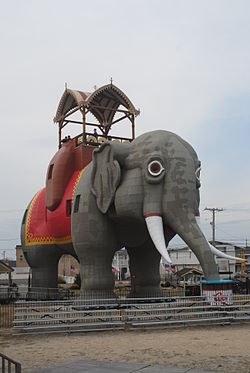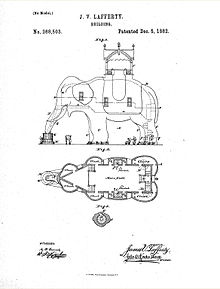Lucy the Elephant
Lucy, the Margate Elephant | |
 Lucy the Elephant, National Historic Landmark, November 20, 2011 | |
| Location | Margate City, New Jersey |
|---|---|
| Built | 1881 |
| Architect | James V. Lafferty |
| NRHP reference No. | 71000493 |
| NJRHP No. | 383[1] |
| Significant dates | |
| Added to NRHP | August 12, 1971[2] |
| Designated NHL | May 11, 1976[3] |
| Designated NJRHP | April 7, 1971 |
Elephant hotel redirects here. For the National Historic Landmark located in Somers, New York, see Elephant Hotel.
Lucy the Elephant is a six-story elephant-shaped example of novelty architecture, constructed of wood and tin sheeting in 1881 by James V. Lafferty in Margate City, Atlantic County, New Jersey, United States, two miles (3.2 km) south of Atlantic City, in an effort to sell real estate and attract tourists.
Today, Lucy is a tourist attraction. Guided tours take visitors into the building through the spiral staircase in the left rear leg up into the interior, then up again into the howdah to see views of Margate, the Atlantic City skyline, and the Atlantic Ocean.
1800s

In 1881, the U.S. Patent Office granted Lafferty a patent giving him the exclusive right to make, use or sell animal-shaped buildings for 17 years. Lafferty paid for the building of his first elephant-shaped building at South Atlantic City, now called Margate. He employed Philadelphia architect William Free to design the building and a Philadelphia contractor constructed the structure at a cost of $25,000 - 38,000.[4] Originally named "Elephant Bazaar", the building is 65 feet (19.7 m) high, 60 feet (18.3 m) long, and 18 feet (5.5 m) wide. It weighs about 90 tons, and is made of nearly one million pieces of wood. There are 22 windows and its construction required 200 kegs of nails, 4 tons of bolts and iron bars, and 12,000 square feet of tin to cover the outside.[4] It is topped by a howdah carriage, also known as a hathi howdah.
Lafferty brought real estate customers up a narrow spiral staircase from within the elephant's body to the howdah, where he could point out real estate parcels available for sale.[5] Lucy's head shape identifies the building as an Asian Elephant, and its tusks as a male. In its first few years, the elephant was referred to as a male, but today it is now generally considered to be female.
The structure was sold to Anton Gertzen of Philadelphia in 1887 and remained in the Gertzen family until 1970. Sophia Gertzen, Anton's daughter-in-law, reportedly dubbed the structure "Lucy the Elephant" in 1902.[4]
Lafferty built at least two more elephant-shaped buildings, though neither survives. The Elephantine Colossus or Elephant Hotel, at Coney Island amusement park in Brooklyn, New York, stood 122 feet (37.2 m) tall, with seven floors of rooms, and legs 60 feet in circumference. It held a cigar store in one leg and a dioramic display in another, hotel rooms within the elephant proper, and an observation area at the top with panoramic sea views. It burned down in 1896. Another, officially named the Light of Asia but dubbed Old Dumbo by locals, went up in Cape May in 1884 and was torn down within 15 years.
1900s
Over the years, Lucy had served as a restaurant, business office, cottage, and tavern (the last closed by Prohibition). The building was depicted on many souvenir postcards, often as "The Elephant Hotel of Atlantic City." (The hotel was in a nearby building, not in the elephant itself.)
By the 1960s, Lucy had fallen into disrepair and was scheduled for demolition. In 1969, Edwin T. Carpenter and a group of Margate citizens formed the Margate Civic Association, which later became the Save Lucy Committee under Josephine Harron and Sylvia Carpenter. They were given a 30-day deadline to move the edifice or pay for its demolition. Various fund-raising events, the most successful a door-to-door canvass by volunteers, raised money. In 1970, the building was moved about 100 yards to the west-southwest and a bit inward from the shoreline. The building was also completely refurbished. The building's original wooden frame was buttressed by a steel one, and the deteriorated howdah was replaced with a replica. A plug of green glass set into the howdah platform refracts light into Lucy's interior.[6]
In 1976, Lucy was designated a National Historic Landmark.
A postcard with a picture of Lucy on it can be briefly seen in the opening credits of the 1983 film National Lampoon's Vacation.[7]
2000s

The building's birthday is celebrated with children's games and much fanfare each July 20 or on the following weekend.
The History Channel television show Weird U.S. featured Lucy.
A Lucy-inspired structure is featured as the boudoir of Nicole Kidman's character in the movie Moulin Rouge 2001.
In 2006, Lucy was struck by lightning, blackening the tips of the tusks. That November, the building was prominently featured in an advertisement for Proformance Insurance.
Lucy was featured in the 2009 television show Life After People, which illustrated how the environment would take over the structure without people to maintain Lucy.
In a 2011 episode of Boardwalk Empire, which takes place mostly in Atlantic City, Agent Van Alden mentions "a hotel shaped like an elephant" among the local attractions.
In October 2012, Hurricane Sandy made landfall near Margate. Lucy remained unscathed, although part of the surge reached the building's toes and a booth in the parking lot was blown over.[6]
Lucy was featured in the 2012 book Stay Close by Harlan Coben (ISBN 1101561173).
June 14, 2014 episode of Travel Channel's Monumental Mysteries featured Lucy the Elephant.[8]
April 18, 2015: Lucy is featured in the Bill Griffith daily comic strip "Zippy the Pinhead".
Lucy is featured in the opening credits of Vacation (2015 film)
See also
- Cultural depictions of elephants
- Elephant of the Bastille
- Charles Ribart and his plan for the site of L'Arc de Triomphe
- National Register of Historic Places listings in Atlantic County, New Jersey
- Tillie, another colorful icon of the Jersey Shore
References
- ^ "New Jersey and National Registers of Historic Places - Atlantic County" (PDF). New Jersey Department of Environmental Protection - Historic Preservation Office. June 2, 2011. p. 5. Retrieved July 12, 2011.
- ^ "National Register Information System". National Register of Historic Places. National Park Service. March 15, 2006.
- ^ "Lucy, The Margate Elephant". National Historic Landmark summary listing. National Park Service. 2008-06-23.
- ^ a b c McMahon, William (1988). The Story of Lucy the Elephant. Margate, N.J.: Save Lucy Committee, Inc. p. 40.
- ^ http://www.njsouth.com/index-lucy.htm
- ^ a b Fears, Danika. "Historic landmark 'Lucy the Elephant' survived Sandy". The Today Show. NBC News. Retrieved 6 November 2012.
- ^ "Lucy the Elephant". CityAtlantic.com. March 2, 2015. Retrieved 2015-03-26.
- ^ "Lucy the Elephant". Monumental Mysteries. The Travel Channel, LLC. Retrieved 15 December 2014.
External links
- Video Tour and Historic Documentary of Lucy the Elephant
- Lucy the Elephant
- Roadside America
- HD Video taken 07 Aug 2009
- "House Built Like Elephant Contains Six Rooms", December 1932, Popular Mechanics
- Historic American Buildings Survey (HABS) No. NJ-816, "Margate Elephant, Atlantic Avenue & Decatur Street, Margate City, Atlantic County, NJ"
- Commercial buildings completed in 1881
- Novelty buildings in the United States
- Roadside attractions in New Jersey
- Buildings and structures in Atlantic County, New Jersey
- National Historic Landmarks in New Jersey
- Visitor attractions in Atlantic County, New Jersey
- Historic American Buildings Survey in New Jersey
- National Register of Historic Places in Atlantic County, New Jersey
- Margate City, New Jersey
- Elephants in art

